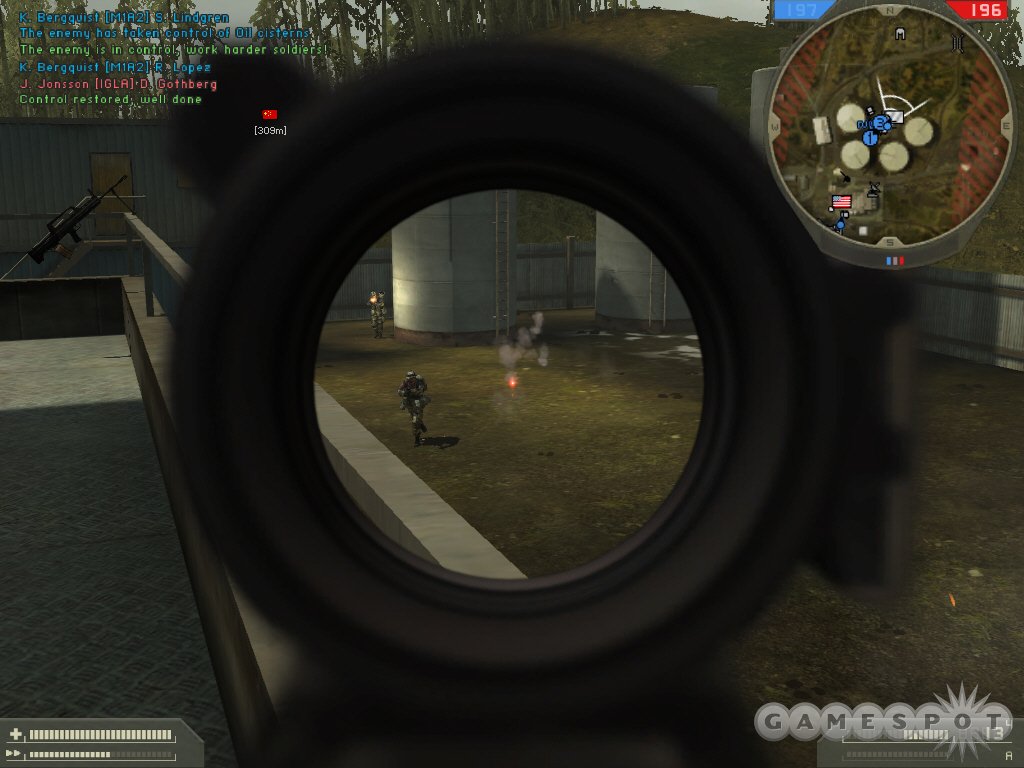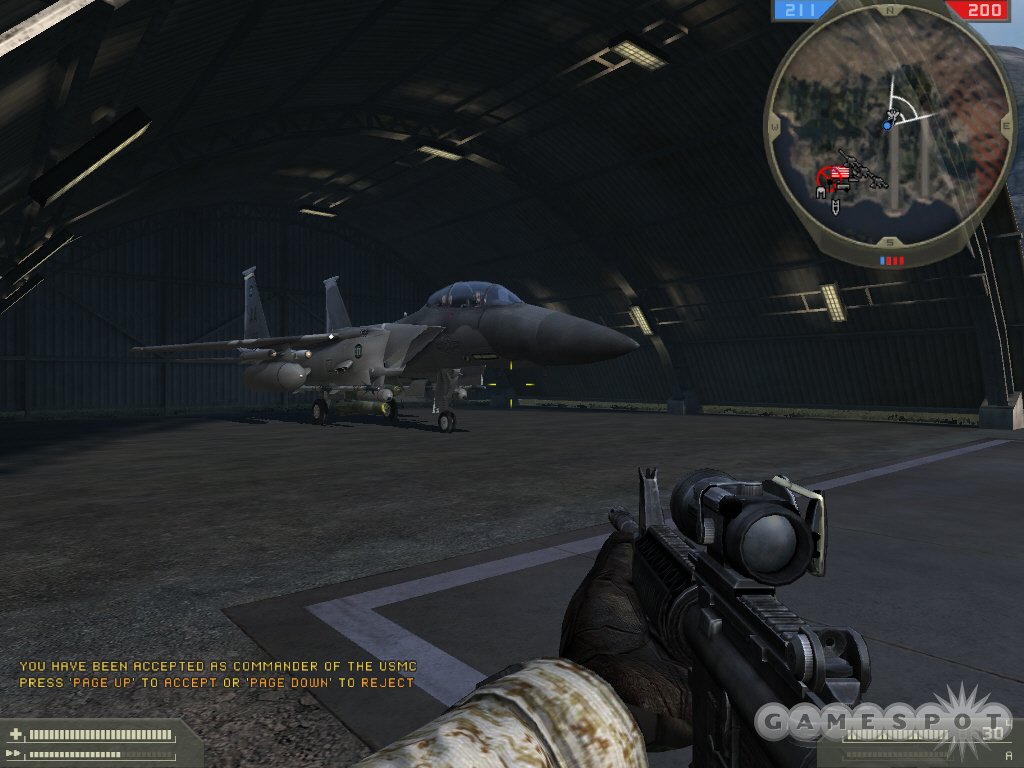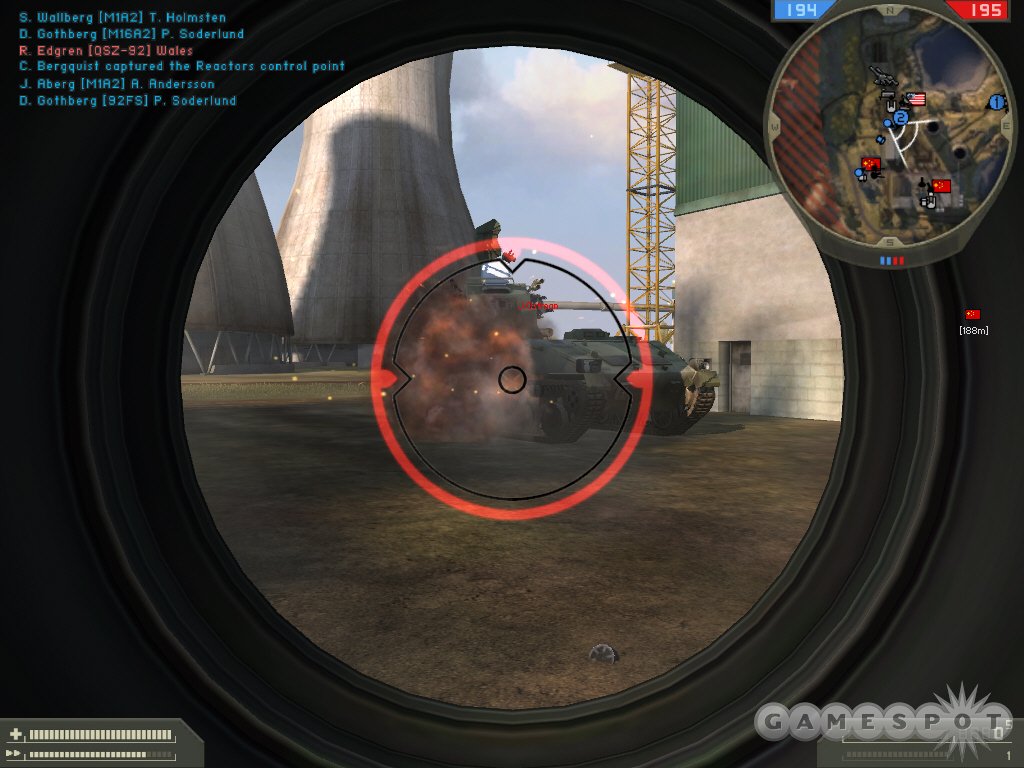Battlefield 2 Updated Q&A - Locked and Loaded and Ready to Go
Now that the game is finished, we caught up with assistant producer Benjamin Smith to discuss the challenges that went into making this highly anticipated sequel.
Battlefield 2 will ship to stores next week, and while we know that you can't wait to get your hands on this highly anticipated sequel, the good news is that you won't have to wait much longer. To help pass the time between now and then, we caught up with Benjamin Smith, the assistant producer for Battlefield 2. With the actual hard work of making the game behind them, it was a good opportunity to ask some reflective questions about the development process, and this included talking about challenges that cropped up, as well as the reasoning for certain design decisions.

GameSpot: How soon after Battlefield 1942 did the team sit down and actually start planning Battlefield 2? Was there a deliberation process in which the team whittled down a list of possible choices for the setting of the game? Why did the team select a modern/near-future conflict, rather than another historical conflict?
Benjamin Smith: The team in Stockholm spent some well-earned time recuperating after Battlefield 1942 shipped and then they worked on the Road to Rome expansion pack. Following this, the team moved into preproduction on Battlefield 2. The team took some time to think about the advantages and disadvantages of setting a Battlefield game in different eras and genres, and since DICE had done World War II and was in the process of starting Battlefield Vietnam in the Canada office, the next logical step was modern era. At the end of the day, we felt it didn't make a lot of sense to stray very far from the vehicle and weapon mix that resulted in the award-winning package that was Battlefield 1942 (like recognizable, drivable land, sea, and air assets in combination with hand weapons that are reasonably straightforward to use), which ruled out pre-World War I as well as far future.
GS: How much of an advance would you say Battlefield 2 is over the previous two games in terms of technology and gameplay? How much have you learned from the previous games in the series, in terms of feedback from fans?
BS: Technologically, we feel that Battlefield 2 is a revolution in comparison to Battlefield 1942. The new rendering engine really does amazing things graphically and also manages to support 64 simultaneous players at the same time. In terms of gameplay, we think that we've kept the core of what made Battlefield 1942 so amazing when it first shipped but have taken it to the next level in terms of team play enhancements (integrated voice-over IP, squads, commander mode). As far as feedback, we always take fan feedback into account in terms of adding features to products postship, like the buddy lists and the voting interface in 1942, or tunnels in Battlefield Vietnam. Obviously, we learned a lot about what people liked and didn't like in the previous Battlefields from interacting with fans and forums, and we had these in mind constantly as we developed and tested Battlefield 2.
GS: Was it easier to develop Battlefield 2 overall, now that the team has the luxury of having the experience of making two other Battlefield games? Or were there all-new challenges that made developing the new game even tougher? Any examples you'd like to share?
BS: Building a sequel that could live up to and surpass its predecessor was a daunting task anyway you slice it. Sure, there are things you get better at from building that predecessor and lessons you can carry over. Our focus on delivering another game of the year candidate kept us on our toes though, and delivered a whole new set of challenges. Primary among these was keeping the game as easy to pick up and play as possible (not overwhelming a new user with data), while at the same time providing that higher level of organization to experienced players who are ready to take the next step. We feel that we hit the target on this goal.
GS: How did the team approach the design to compensate for the fact that modern weaponry is so much more lethal and effective than World War II- and even Vietnam-era weaponry? Was it simply a matter of scaling back the lethality of various vehicles and weapons?
BS: The emphasis in Battlefield is always going to be arcade action over realism, so in a lot of ways the overall lethality of weaponry (or even relative lethality) is not going to be a reflection of the real world. Just as an example, while the M1A2 has, in reality, proved ridiculously hard to disable in the real world, all three main battle tanks in Battlefield 2 are treated as pretty much equivalent in gameplay terms. We've also given some kits body armor to make them more resistant to modern ballistic weapons and, overall most weapons are not one-hit, one-kill as they would be in real life (given a high-lethality hit location).

GS: Tell us about the process of designing maps that can scale in size from 16, 32, and 64 players. How tough was it for the designers to wrap their heads around these expanding maps? What were the design considerations for each map size? What were some of the lessons learned from previous Battlefield maps, layouts, and vehicle spawns (and "tactical suppression," also known as "spawn camping")?
BS: The biggest lesson learned in Battlefield 1942 is that it is simply no fun to walk across the desert in El Alamein. So to that point, control points are generally more evenly spaced in Battlefield 2 and the vehicle concentration is much higher than before to make sure that there is usually some vehicle available to that poor guy who just spawned a mile behind the front lines. Obviously, this was more of a focus in the larger 32- and 64-player maps. There are still plenty of vehicles in the 16-player maps to cover basic needs, but as these conflicts take place on a relatively small section of the map and have only three or four spawn points, it's not as much of a deal to hoof it. In terms of what our executive producer refers to as "tactical suppression," well, it's still possible, but generally home spawn points are either uncapturable or quite far behind the lines.
I Fought the LAW, and the LAW Won
GS: Tell us about how the team went about developing the various kits in the game? How did feedback from the previous games (like the extremely powerful M-60/LAW from Battlefield Vietnam) figure into development? Any idea if the game's kits offer more room for new additions, like a new kit or two in a possible future expansion pack or add-on, or was the game designed entirely around the main kits? 
BS: One major difference compared to Battlefield Vietnam is that the team in Stockholm that is building Battlefield 2 (and built Battlefield 1942) balances the kits pretty much directly. In other words, where in Battlefield Vietnam one team's assault kit carried the M60 and LAW and another team's kit carried an antiaircraft weapon and pistol, the assault kits in Battlefield 2 are pretty much identical in capability (with some occasional differences in damage and deviation between the sides). Weapon balance was one of our heaviest emphasis on testing Battlefield 2, and we went to great lengths (logging play sessions and looking for weapons that stood out as accruing an excessive number of kills compared to the rest, or were used far more often than the rest) to ensure that balance issues will not be endemic to our launch. As to expansion plans, there are always opportunities to add new weapons or heavily tweak kits, as we did in the expansion packs in Battlefield 1942.
GS: Now that real-time voice chat has been built into the game, obviously voice is going to be important. What do you think voice will add to the game in all, and how widely do you think it will be used? How much of a disadvantage will you be at if you or your team doesn't use or have access to voice?
BS: Battlefield is a team game, so if any team is composed of 8, 16, or 32 lone wolves, they're likely to be at a disadvantage if the other team is making use of communication and coordination tools. In 1942 and Vietnam this would have been either the prescripted communication lines ("Requesting a pickup!") or a third-party voice application. In Battlefield 2, we've provided a plethora of tools intended to make it easier to play the game as a team. Our hope is that people will make heavy use of squads and integrated VOIP, whether with a regular group of friends or with Joe Schmo. Players who do use the tools we've built and end up working together with a group of players, coordinating land, sea, and air assaults to take or defend a control point, will get to experience more of those "Battlefield moments" that defined 1942 and Vietnam. That's not to say that "lone wolf" is bad, because it's not (everyone wants to just sit and shoot things mindlessly once in awhile), but you may miss out on a lot of what sets Battlefield apart from the crowd.
GS: It seems like Battlefield games keep moving forward chronologically. It started with World War II, transitioned to Vietnam, and now you've explored a near-future conflict. But do you think the team may end up going back and exploring a historical conflict for the next game, or do you think this is a series that could move forward into futuristic, science-fictional territory? Or perhaps another hypothetical conflict, such as a Warsaw Pact/NATO war?
BS: While the possibilities are pretty much endless, we haven't really mapped out a course for the future of Battlefield yet. Battlefield as a franchise is focused on vehicles and infantry mixing it up on a recognizable battlefield with arcade action. Obviously, these values could translate to a lot of eras, so we certainly have options when we do sit down to plot our course. I would say that we're just as likely to go backward as we are forward (or stay still).
GS: We've seen the incredible in-game footage trailers made using Battlefield TV. Will it be easy for players to create their own similar movies? What sort of video-editing software will they need, if any? What are the best features of Battlefield TV, and who will get the most out of them?
BS: Battlefield TV will do everything except piece the rendered footage you have created from saved game sessions, so while it will be relatively easy for you to save, admire, and render out your gameplay moments, you will need a third-party application to piece these together, if you need to. Something like Adobe Premiere will do. We feel that Battlefield TV has myriad uses from the casual player who just wants to relive that last awesome match on the Gulf of Oman, the dedicated machinimist who wants to create his or her magnum opus, the clan leader who wants to analyze the tactics from his team's last match, or the tournament administrator looking to track whether a player was making any suspicious kills. All of these constituencies should love Battlefield TV.
GS: What can you tell us at this point about your plans for supporting the game after release? Naturally, we assume that you'll be on the lookout for bugs and exploits, but are there plans for potential expansion? Maybe one of those free map packs, or a total conversion, like the World War II add-on for Battlefield Vietnam?
BS: We will support Battlefield 2 postlaunch in the same manner that we supported Battlefield 1942 and Vietnam. This includes feature additions, new maps, new vehicles and weapons, etc. Also, as you note, we'll spend a good deal of time looking through community feedback with each release and address any items that really cry out for resolution, just as we have done previously.
GS: Finally, crazy moments happen all the time in Battlefield games. What's your favorite moment so far during Battlefield 2's development?

BS: Honestly, my favorite moment is a little embarrassing. I was piloting a helicopter quite poorly and decided to bail out. I opened my chute and was just about to touch down when my teammate ran under me, heading for an antiair defense station. Well, I landed on top of him, squishing him and gaining a team kill. I knew that the commander's supply crate could crush players, but I had no idea that another player could until I got firsthand experience. It was hilarious! It also goes to show just how cool our physics system is.
GS: Thanks very much, Benjamin.
Got a news tip or want to contact us directly? Email news@gamespot.com
Join the conversation